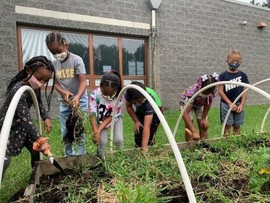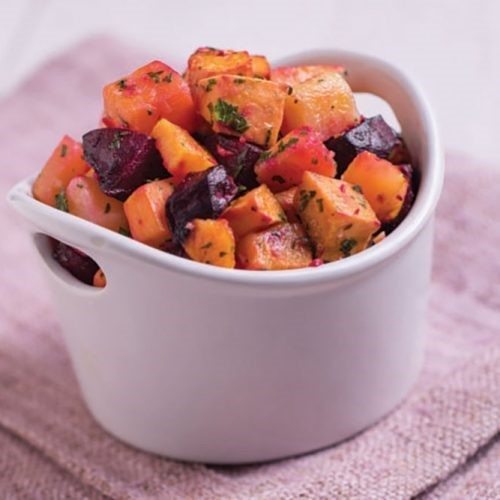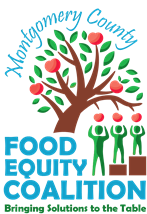|
|
Ohio Farm to School Monthly Newsletter
Cultivators + Classrooms + Cafeterias
Issue #2 | December 2021
|
|
 Students gardening at Oakmont Elementary School in Columbus, Ohio.
|
|
Welcome to the December edition of the Ohio Farm to School Newsletter! Produced monthly in coordination with the Ohio Department of Education, Ohio Department of Agriculture, and The Ohio State University Extension Farm to School Program, the publication will bring resources and stories from across Ohio highlighting and celebrating work being done in the field to bring the benefits of Farm to School programming to children of all ages.
|
|
 Local Harvest Bake is root vegetables roasted with garlic, salt, and olive oil.
|
|
Sweet potatoes are the perfect seasonal item for school meals! They are an excellent source of potassium, vitamin C, folate, and vitamin B6 and meet the red/orange NSLP vegetable subgroup requirement.
Try this Local Harvest Bake from the Institute of Child Nutrition that features fall favorites like butternut squash, beets, and sweet potatoes. One 1/2 cup portion (No. 4 fl oz spoodle) provides ³⁄8 cup red/orange vegetable and ¹⁄8 cup other vegetable.
|
|
|
Want to be featured in the next monthly newsletter and on Ohio's Farm to School Websites or have an upcoming event we can share? Submit your F2S Success Story here!
Region Highlight: West Central

The West Central Farm to School Region includes Mercer, Auglaize, Darke, Preble, Shelby, Miami, Montgomery, Greene, Clark, Champaign, and Logan counties. The region is led by Haley Carretta, Food Systems Project Manager at Public Health - Dayton & Montgomery County. Carretta is building out the Montgomery County Food Equity Coalition to include Farm to School stakeholders throughout Ohio’s West Central region. The region’s F2S network organized increased participation in the Great Lakes Great Apple Crunch to celebrate locally grown apples for National Farm to School Month.
Apples were purchased from four different producers in the region: Monnin’s Fruit Farm in Dayton, Crossroad Orchard in Miamisburg, Bayer’s Melon Farm in West Dayton, and Tuken’s Orchard and Farm Market in West Alexandria. The apples were provided to elementary students, an afterschool program, a childcare center, and Head Start programs.
The Food Equity Coalition plans to expand the event next year and develop relationships with schools to promote local foods in the region.
|

|
|
|
-
All Ohio Farm to School stakeholders are invited to join the Ohio Farm to School Network Quarterly Meeting on Thursday December 9th 9:30am-noon! Topics include statewide expansion of Feed or Future’s “Local Menu Takeover,” supply chain challenges and new opportunities for local foods, and regional breakout sessions. Please register for the meeting HERE and feel free to share with partners across the state.
-
Rural Action's Sustainable Agriculture program is currently hiring a Beginning Farmer Outreach Assistant. Learn more here.
-
School Gardens of Ohio Network Meeting on December 8th 4:30-6pm. Register here.
 Apple Crunch Day at Dixie Elementary in New Lebanon, Ohio
|
USDA annually awards competitive Farm to School grants that support planning, developing, and implementing farm to school programs. Open to state, regional, and local organizations, these grants are an important way to initiate, expand, and institutionalize farm to school efforts. The Fiscal Year (FY) 2022 Farm to School Grant RFA is now open and can be found at Grants.gov.
Visit the Grant Applicants Resources page to access other helpful resources, including webinars on applying for a Farm to School Grant.
Local Foods can be a convenient and reliable source to offset current supply chain interruptions. 2 CFR 200 allows for short term emergency purchases to continue uninterrupted food service using noncompetitive procurement methods. There is no need to request a waiver or receive State agency approval and child nutrition program sponsors may use this procurement method as long as the supply chain disruption occurs. For example, if a school or childcare center experiences an unanticipated food order cancellation, they may go to the local grocer, dairy, farm, orchard, or co-op to purchase food as many times as they need using the emergency procurement method until their next food order arrives or do an emergency one-year sole source emergency procurement to ensure they have food the entire school year. See the Emergency Procurement Due to Supply Chain Disruptions Questions and Answers and the Procuring Local Foods Child Nutrition Program Guide for more information.
|
|
|
|
|